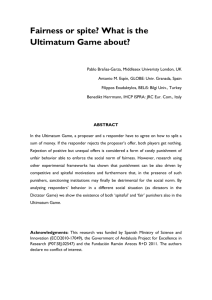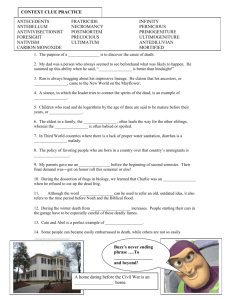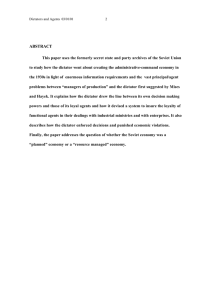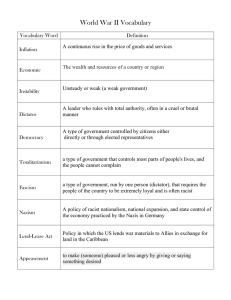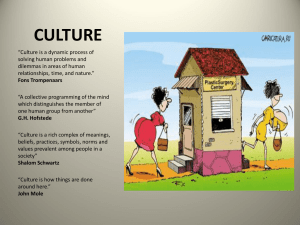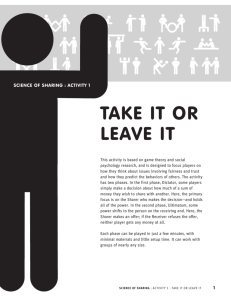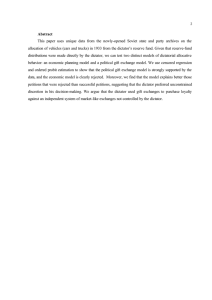A Cross-cultural Study of Playing Simple Virtual Humans Elnaz Nouri, David Traum
advertisement
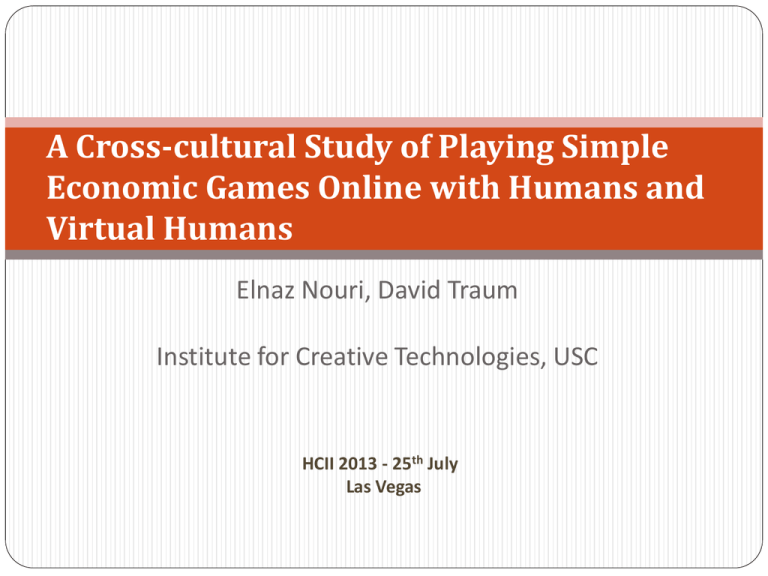
A Cross-cultural Study of Playing Simple
Economic Games Online with Humans and
Virtual Humans
Elnaz Nouri, David Traum
Institute for Creative Technologies, USC
HCII 2013 - 25th July
Las Vegas
Abstract
We ran simple online economic interactions
between virtual human and people from two
countries (India and US).
We compare our results to:
Previously reported findings of similar
interactions run in the laboratory.
Questions we try to answer
Opponent’s effect: How similar or
different do participants feel and act
when playing a virtual human versus
another person?
Culture’s effect: How different are players
from the United States from Players in
India?
Game’s effect: What impact does the type
of game have on players’ decisions and
values?
In this talk
Previous work:
Cultural differences in decision-making games and values
MARV model and MARV survey
Social aspects of human-agent interaction
On-line AMT Study and experiment details
US and Indian participants
Human vs. Virtual Humans
Dictator or Ultimatum game
Results
Cross-cultural differences in game play and personal values
Game effect
Opponent effect
Conclusion
Previous Work
In-person games have been for understanding people's economic
decision making behavior. (Camerer, 2003)
Ultimatum game(Guth, 1983),
Dictator game(Bolton, 1998),
Prisoner’s Dilemma (Rapoport, 1965)
…
An example: Ultimatum Game
Two players can split a certain amount of money (Güth, 1982). Two turn game:
1.
2.
Proposer: make an offer
Responder: accept or reject the offer
Expected Results:
Offer the minimum amount possible
Accept any offer greater than zero
Cultural Variations in Ultimatum Game
Observations:
Proposers offer about 40 – 50$ on average.
Responders reject offers of 20$ or less. (Camerer, 2003)
Considerable variation of offers and acceptance rates across 4 cultures (Roth 1993;
Camerer 2003)
(Roth, 1993)
OFFER-100
OFFER-90
Israel
OFFER-80
0
OFFER-70
Israel
US
OFFER-60
US
Japan
OFFER-50
0.1
Japan
Yugoslavia
OFFER-40
0.2
Yugoslavia
OFFER-0
0.3
OFFER-30
0.4
OFFER-20
0.5
1
0.9
0.8
0.7
0.6
0.5
0.4
0.3
0.2
0.1
0
OFFER-10
0.6
MARV Model (Nouri, 2011)
MARV = Multi-Attribute Relational Values
Goal: Internal computational model of decision making for agents that is sensitive
to culture, and produces behavior consistent with observations of that culture
Approach: applying multi-attribute decision-making model to calculate utility of
decisions
•
assigning appropriate weights to each of the following attributes:
VS08up
Hofestede
Survey
Methods for setting
the
weights
Questions:
1.
have sufficient time for your personal or home life
2.
Q2 have a boss (direct superior) you can respect
Previous Methods for determining culture-specific
weights on attributes:
(IDV)
1. Intuitions based on Hofstede’s dimensional
(PDI) model of culture (Nouri & Traum
3.
get recognition for good performance (MAS)
4.
have security of employment (IDV)
2. Machine learning from human behavior
(Nouri
et al CogSci
5. datahave
pleasant
people2012)
to work with (MAS)
6.
do work that is interesting (IDV)
New method Directly ask participants
much by
they
7. how
be consulted
yourcare
boss inabout
decisionsthe
involving
your work (PDI)
weights (Nouri and Traum GDN 2013) 8.by assigning
weights
from -5 to 5. (-5
live in a desirable
area (MAS)
Hofstede dimensions of cultural values
have
a job
respected
by your about
family and
means they don’t care about that value whereas 9.
5 shows
they
care
significantly
thefriends
value.)
(IDV)
100
93.7
91.0
10.
have chances for promotion (MAS)
90
PDI: Power Distance
(large80.6vs. small),
11.
keeping time free for fun (IVR)
69.6
80
73.9
IDV: Individualism
vs. Collectivism,
12.
moderation:
having few desires (IVR)
68.0
13.
being
generous
to other people (MON)
70
MAS: Masculinity
vs. Femininity,
62.0
14.
modesty: looking small, not big (MON)
60
UAI: Uncertainty
Avoidance
(strong
vs.
15.
If there is something expensive you really want to
42.7
46.0 49.2
US not
calculated
scores what do
50
buy but you do
have Hofstede's
enough money,
weak),
40.0
you do? (LTO)India calculated Hofstede's scores
40
LTO: Long- vs.
Short-Term Orientation, 29.0
16.
How often do you feel nervous or tense?(UAI)
30
24.6
17.
Are you a happy person? (IVR)
IVR: Indulgence vs. Restraint, and
18.
Are you the same person at work (or at school if
20
MON: Monumentalism
vs. Selfyou’re a student) and at home? (LTO)
10
19.
…
0.0
CMVC 2011)
Effacement.
0
PDI
IDV
MAS
UAI
LTO
IVR
MON
MARV Survey
Abbreviation
Value Description
Vself
Getting a lot of points
Vother
The other player getting a lot of points
Vcompete
Getting more points than the other player
Vfairness
having the same number of points as the other player
Vjoint
Making sure that if we add our points together we got as many points as
possible
Vrawls
The player with fewest points (whoever that is) gets as many as possible
Vlower bound
Making sure to get some points (even if not as many as possible)
Vchance
The chance to get a lot of points (even if there's also a chance not to get any
points)
Rating scale: from -5 (no importance at all) to 5 (significantly imporant)
Experiment Set Up
Played online version Ultimatum Game or Dictator
Game over 100 points
The Ultimatum Game. as described.
The Dictator Game. played exactly like the standard
Ultimatum Game, except that the responder is not given
an opportunity to accept or reject the offer.
Paid based on their performance in the game:
$0.5 show up fee
Could earn another $0.05 for each additional 10 points
that they accumulated in the game.
Snapshot of the SimCoach character
http://labs.simcoach.org/simcoach/?space=mini&character=3072
Experiment Procedure
Before Game:
1.
2.
Fill out the VS08 Hofstede Survey and demographic
information questions
Receive instructions about the game (Dictator Game or
Ultimatum Game) denoting they would be playing with
another participant from their country.
The Game:
Play the proposer in Dictator Game or Ultimatum
game
2. Fill out the MARV Decision-making values survey
3. (in the case of the ultimatum game) Receive their
partner’s move and their final reward.
1.
Study Participants
Indian and US participants recruited on Amazon
Mechanical Turk.
Number of
Dictator Game
players from India
Ultimatum Game
Human
107
101
Virtual Human
38
47
Number of
players from US
Dictator Game
Ultimatum Game
Human
107
101
Virtual Human
46
53
Results
Results: Game Effect
Offer Distribution
Offers:
The offers made in the two games are
significantly different from one another.
Average Offer
in Dictator
Game
Average Offer in
Ultimatum Game
39.6
47.6
• Values:
are significantly different between the
two games:
{Vother , Vcompete, Vequal , Vjoint, Vrawls,
Vlower bound}
Results: Culture’s Effect
Average US offers
US
Offers:
44.16
Average India offers
India
41.44
Significant difference between the two cultures when
playing ultimatum game with Virtual humans (p value<0.05).
Values:
Significance difference between the values reported by
Indians and Americans (across all conditions):
{ Vself, Vcompete, Vchance}
When playing with Virtual Humans
{ Vother in dictator game, Vlowerbound in ultimatum game}
Results: Opponent’s Effect
Offers:
Playing against a virtual human or a human
does not bring about significant difference in
the offers made in the games.
Indians played differently when playing
ultimatum game with a virtual human as
opposed to a human (p value<0.05).
Values:
Significant differences in the values reported
{ Vself, Vother, Vcompete, Vrawls, Vlower bound, Vchance}
Prediction of offers
Accuracy of prediction
Percent correct
Dictator Game Ultimatum
Game
Country (US or India)
Hofstede Scores (7 dimensions)
Hofstede Questions (28 questions)
Decision-making Values (8 values)
Random baseline: frequency of offers in the
data
39.55%
39.56%
39.24%
52.86%
21%
51.61%
50.05%
53.52%
54.90%
32%
Most common offer baseline (50%)
38%
51%
Prediction of Culture
percent correct
Dictator
Game
Ultimatum
Game
Offers (11 values)
Hofstede Scores (7 dimensions)
Hofstede Questions (28 questions)
Decision-making Values (8 values)
53.40%
64.42%
76.39%
60.09%
54.11%
69.85%
77.79%
65.70%
Random Baseline
50%
50%
Conclusion
*** Our results are consistent with reported results in the literature.
Opponent’s effect: People from US and India both treat virtual
humans similar to how they would have treated another human.
We conclude that virtual humans can be a reasonable substitute to humans
in online economic interactions. (eg. Selling and negotiation)
Culture’s effect: Values held by people from the two countries are
different under similar conditions and the reasons should be further
investigated.
Game’s effect: The most prominent cause affecting the game behavior
and the offer values is the type of the game being played.
Future Work
More data collection
More cultures
More types of games (potential for other values to be
distinguished)
Modeling
Culture-specific agent models based on reported values
Correlations between Hoftstede questions/dimensions
and values (for cultures with no values data reported)
Thank you!
Questions?
